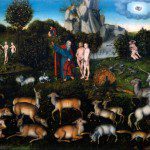 The final case study in origins considered by Gerald Rau in his book Mapping the Origins Debate: Six Models of the Beginning of Everything is the Origin of Humans. From a strictly natural, scientific, viewpoint this may be considered nothing more than a subset of the origin of species considered in the last post. From a Christian point of view, however, the origin of humans looms large. As Rau notes:
The final case study in origins considered by Gerald Rau in his book Mapping the Origins Debate: Six Models of the Beginning of Everything is the Origin of Humans. From a strictly natural, scientific, viewpoint this may be considered nothing more than a subset of the origin of species considered in the last post. From a Christian point of view, however, the origin of humans looms large. As Rau notes:
In another sense, however, it is a distinct question that is central to the debate, because the underlying issue is whether humans are qualitatively or only quantitatively different from animals, whether we are unique or just smarter. Is there more to a person than meets the eye (or other sense organs): do we have a soul or spirit (and if so, are the two identical), and do we bear the image of God (and if so, what exactly does that mean)? (p. 129)
Most of these questions, Rau claims, fall beyond the scope of science. Science can address the origin of the human body and the connection between mind and brain. Science can not really address questions of soul and has no appropriate scope or language for the concept “image of God.”
With respect to the evidence for the origin of the human body Rau gives a brief outline of the evidence. This really falls in two categories: the fossil evidence and the genetic evidence. The fossil evidence is either sparse or abundant depending how one wishes to argue. There are some 6000 fossils of early human or human-like individuals. Some are nearly complete, while many are represented by only one bone of some sort. Some species have multiple examples and some only one or two. The website on human fossils sponsored by the Smithsonian gives a good overview.
The genetic evidence for development of the human body over time is even more compelling. He discusses the evidence for chromosome fusion where chromosome 2 of humans is consistent with the fusion of two chromosomes found in chimpanzees. Humans have 23 pairs of chromosomes while chimpanzees and apes have 24. The gene order, the presence of a residual telomere in the middle of gene 23, and the presence of an inactive centromere all point to gene fusion. The mechanism by which this occurred isn’t clear, but the evidence that it occurred is quite clear.
Rau also runs through all of the various estimates given for the similarity of the human and chimpanzee genome. These range from very high (99%) to rather low. The discussion illustrates some of the confusion as nonscientists try to interpret the claims of various scientists. It isn’t that the estimates are in substantive disagreement as much as that they are fundamentally different estimates, a bit like comparing apples and oranges. The estimates may refer to segments that code for protein, and may refer to larger segments of the genome (most of the genome does not code for protein). The expression of genes is regulated at least in part by noncoding regions of the DNA, and the expression of the various genes differ far more than the actual coding sequence.
So what about the interpretation?
Rau claims that there are three significant questions that must be answered: (1) Is there such a thing as a human soul or spirit? (2) How does God interact with his creation? and (3) How is Genesis to be interpreted?
A. No God. Naturalistic evolution denies the existence of the soul, of God, and doesn’t much care about the interpretation of Genesis. The natural world is the only reality.
B. Hands-Off God. According to Rau’s classification nonteleological evolution and planned evolution both believe in God and in a soul (of some sort). God, however, does not intervene in the world in a manner that can be studied by science. By definition these positions accept nonoverlapping magisteria and view science and religion as answering different questions. Thus, as the scientific evidence demonstrates, there was never a time when there was a unique pair corresponding to Adam and Eve, progenitors of the human race.
If humans did not arise from a single man and woman at a particular point in time, various explanations are possible of how humans might have arisen. First, awareness of God and sinfulness could have arisen slowly in a group of primates over many generations, so there was no single point in time at which pre-humans became human. This interpretation, in accord with Darwinian gradualism and the idea of nonintervention, is the one espoused by most proponents of evolutionary creation at the present time. (p. 145)
C. Hands-On God. By Rau’s definition directed evolution does not restrict the way in which God intervenes in the world. This position therefore allows for a special purpose in creation. “According to this view God does not intervene in the world only at particular times; it would be better stated that he is constantly involved in sustaining and directing it.” Many different submodels are then consistent – some of which involve a literal Adam and Eve, others involve God imparting his image to a population.
In Rau’s classification those who hold to directed evolution tend to emphasize the number of changes between humans and apes rather than the similarities. The rapidity of the development over the last several million years is also highlighted. “As with the origin of other species, DE claims this would be far more likely if changes were purposefully directed rather than random.” (p. 147)
D. Special Creation by God. Both old earth and young earth creation include the special creation of a unique pair, Adam and Eve. God created their bodies without progenitors, in the image of God, with a spirit and soul. Humans are therefore qualitatively different from the animals in both body and soul. The evidence for common descent claimed by proponent of evolution is argued to be evidence instead for common design.
What Difference Does It Make?
The question of human origins is a contentious issue because it cuts to the very core of our being. Rau highlights theological issues (sin, death, inerrancy of scripture), personal identity, and social issues.
The theological issues are of little concern to those who hold to naturalistic evolution, but of significant concern and disagreement among proponents of the other five positions Rau describes. We have discussed many of the theological questions over the last five years, and will continue to discuss them into the foreseeable future. At the heart of the question for many is the appropriate way to interpret Genesis. This is not as straightforward as it may seem because we need to consider the audience for which the text was originally written. Rau gives an interesting example:
Furthermore, if I write, “He went through a yellow light,” my meaning would be perfectly clear to present-day readers, but perhaps less so to readers forty centuries from now, trying to figure out what kind of light I was talking about and how someone went through it. (p. 149)
When John Walton talks about function as central to the appropriate interpretation of Genesis, it is in an attempt to get back to the mind of the audience some forty centuries ago, not an attempt to twist Genesis into something that it is not. (See the other post today or his book The Lost World of Genesis One for more details.)
Personal identity is a big issue, but here Rau sees the dividing line falling primarily between the theistic and nontheistic positions. Naturalistic atheism leads to nihilism or existentialism as the only logical conclusions “either we say that life is meaningless and do whatever we please, or we create a meaning for ourselves and no one can tell us whether our chosen purpose is good or bad, a relativistic perspective.“
He contrasts this with theism – any of the five models from non-teleological evolution to young earth creation. “If theism is correct, there is a basis for morality that transcends the individual, and a purpose for living beyond this current life.” (p. 150) This gives hope, but also leads to questions of theodicy.
Rau also notes that personal connection with a church community plays a large (often defining) role in the position that different Christians take on the questions of origins including human origins. “Individual thought is stifled by a commitment to the unity of the whole.” (p. 151) Leaders play an enormous role here, but also find it difficult to turn the juggernaut.
Social issues. Rau sees a huge distinction here – again between theistic and nontheistic positions. If we are created in the image of God we have an innate worth and purpose. We are not merely another animal with no special significance in the grand progression of the universe from big bang to … whatever.
According to Rau:
The logical outcome of naturalistic Darwinism, although many proponents refuse to accepts it, is social Darwinism. When there is a struggle for resources, it would be in our best interests to allow the infirm to be eliminated from the population. (p. 151)
The personal and social issues play a large role in the reaction of many Christians to evolution. All evolution is painted with the brush of naturalistic evolution.
Note – this does not mean that all who are not theists are automatically nihilists, existentialists, relativists, or hold to social Darwinism. Many are, in fact, active in a wide range of humanitarian activities. Rau is suggesting what he sees as the logical conclusions – but few of us carry our convictions to “logical conclusions.”
Final Words. Rau’s discussion here leaves room for a wide-ranging discussion. His categories help to frame the discussion. Again I find his rather rigid categorization of planned evolution and directed evolution unsatisfactory. The only choices are not a hands-off God, or an obviously hands-on God, non-overlapping magisteria or an “intelligently driven” process.
On another issue – I think he is right in the last section to draw a strong line between the consequences of a purely natural view and a theistic view. But his characterization of the nontheistic view is likely to raise many complaints from the proponent of this view and we should welcome a discussion of this as well.
Finally – what is means to be human, created in the image of God, is a big question. Evolution is not the only, or even the primary, source of questions on this count. Neuroscience and psychology (including, but not limited to, evolutionary psychology) also raise huge questions. Upcoming posts on the books by Malcolm Jeeves will provide an opportunity to consider many of these issues in much greater detail. (See Ask Jeeves! for links and an introduction.)
What do you see as the biggest questions in the area of human origins?
If you wish to contact me directly you may do so at rjs4mail [at] att.net.
If interested you can subscribe to a full text feed of my posts at Musings on Science and Theology.












